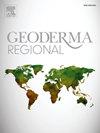Soil carbon sequestration under N fertilized or mixed legume-grass pastures depends on soil type and prior land-use
IF 3.1
2区 农林科学
Q2 SOIL SCIENCE
引用次数: 0
Abstract
Grass-fed beef operations with well-managed pastures mixed with stoloniferous forage legumes are an alternative to increase animal productivity and sequester carbon (C) in the soil. However, using the same system, differences in response time and C sequestration may occur when established in different regions. The objective of this study was to evaluate the impact on C and nitrogen (N) stocks in the soil due to the implementation in the same year, of pasture systems with and without N fertilization or mixed with stoloniferous forage legumes in two regions under different edaphoclimatic conditions. The two experiments were established at the same time and carried out in two areas contrasting in soil type and edaphoclimatic features. The first area was in a transition between the Cerrado and the Atlantic Forest biomes with a Ferralsol with a uniform clayey texture (Lavras site). The second area was in an Atlantic Forest biome with an Acrisol with low natural fertility and sandy texture (Itabela site). Marandu grass (Urochloa brizantha cv. Marandu) fertilized or not with N or mixed with forage legumes for a shorter and longer times were evaluated. Soil samples were taken at the start of the study and after 8 and 15–38 years of grazing and analyzed for total C and N, 13C abundance and fractionation of soil organic matter. After the first eight years at Lavras, the soil indicated that C and N stocks were starting to increase under this management after a long period of plough tillage for maize production. The longer-term pastures (after 15 and 20 years of establishment) mixed with forage legume or fertilized with N, respectively, showed that C stocks recovered to their original status under the native vegetation at the Lavras site. At Itabela, the soil C and N stocks were similar to the stocks under the native vegetation even after 35 or 38 years of mixed pasture, but the stocks were far lower than at Lavras, which can be attributed to the much coarser soil texture. Pasture systems of similar productivity may promote the accumulation of very different C stocks depending on the land use history prior to their installation and soil clay content.
氮肥或豆草混播牧场的土壤固碳能力取决于土壤类型和先前的土地使用情况
使用管理良好的牧草与有匍匐茎的豆科牧草混合饲养草饲牛肉是提高动物生产率和土壤固碳(C)的另一种方法。然而,使用相同的系统,在不同地区建立时,反应时间和固碳能力可能会出现差异。本研究的目的是评估在不同气候条件下的两个地区,在同一年实施施氮肥或不施氮肥或与有匍匐茎的牧草豆科植物混合的牧草系统对土壤中碳和氮储量的影响。这两项实验是同时建立的,并在土壤类型和气候特征截然不同的两个地区进行。第一个地区位于塞拉多生物群落和大西洋森林生物群落之间的过渡地带,土壤为具有均匀粘土质地的Ferralsol(Lavras地点)。第二个区域位于大西洋森林生物群落中,其土壤为天然肥力较低的砂质脆性土壤(伊塔贝拉地点)。对马兰度草(Urochloa brizantha cv. Marandu)施氮肥或不施氮肥或与豆科牧草混合施氮肥的时间长短进行了评估。在研究开始时以及放牧 8 年和 15-38 年后采集土壤样本,分析总碳和总氮、13C 丰度以及土壤有机物的分馏。在拉夫拉斯的头八年,土壤表明,经过长期的玉米生产犁耕后,在这种管理下,C 和 N 储量开始增加。分别与饲用豆科植物混合或施用氮肥的长期牧场(建立 15 年和 20 年后)表明,在拉夫拉斯的原生植被下,土壤中的碳储量恢复到了原来的状态。在伊塔贝拉,即使混合种植牧草 35 年或 38 年后,土壤中的碳储量和氮储量仍与原生植被下的储量相似,但储量远低于拉夫拉斯,这可能是由于土壤质地更为粗糙所致。生产力相似的牧场系统可能会促进非常不同的碳储量的积累,这取决于牧场系统建立之前的土地利用历史和土壤粘土含量。
本文章由计算机程序翻译,如有差异,请以英文原文为准。
求助全文
约1分钟内获得全文
求助全文
来源期刊

Geoderma Regional
Agricultural and Biological Sciences-Soil Science
CiteScore
6.10
自引率
7.30%
发文量
122
审稿时长
76 days
期刊介绍:
Global issues require studies and solutions on national and regional levels. Geoderma Regional focuses on studies that increase understanding and advance our scientific knowledge of soils in all regions of the world. The journal embraces every aspect of soil science and welcomes reviews of regional progress.
 求助内容:
求助内容: 应助结果提醒方式:
应助结果提醒方式:


